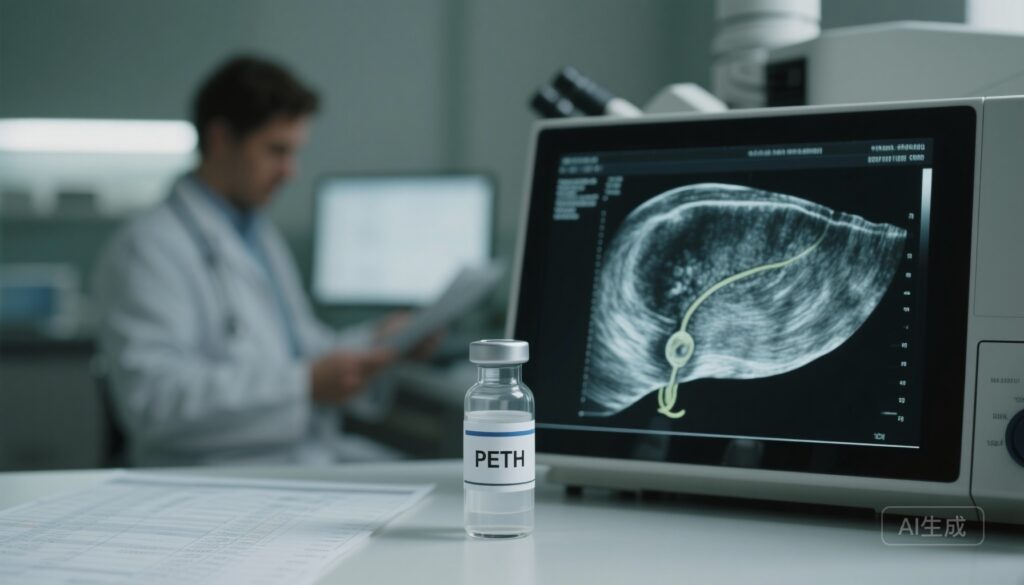Highlights
– Phosphatidylethanol (PEth), a direct biomarker of recent alcohol use, correlated strongly with self-reported 1-week and 3-month alcohol intake (Spearman r ≈0.63–0.73) in two at-risk cohorts.
– PEth detected likely underestimation of alcohol intake in 39.5% of participants with a history of excess drinking and 11.1% of a metabolic-risk group; across participants with steatosis, 39.0% had PEth ≥20 ng/mL suggesting clinically relevant alcohol exposure.
– Routine PEth testing would be diagnostically redundant for about 40% of participants (those with clear low- or high-risk self-report and concordant AUDIT-C), supporting a targeted testing strategy.
Background: clinical context and unmet need
Steatotic liver disease (the spectrum that includes fatty liver with varying contributions of metabolic dysfunction and alcohol) is a leading cause of chronic liver disease worldwide. Accurate subclassification into metabolic dysfunction-associated steatotic liver disease (MASLD), metabolic and alcohol-related liver disease (MetALD), or alcohol-related liver disease (ALD) is important for prognosis, management, and resource allocation. Current subclassification primarily relies on self-reported alcohol intake, which is susceptible to recall errors and social desirability bias. Phosphatidylethanol (PEth) is a direct ethanol-derived phospholipid formed in red blood cells after alcohol consumption; it is detectable by sensitive methods (e.g., LC–MS) for approximately 1–4 weeks after consumption and offers high specificity for ethanol exposure. Whether PEth can meaningfully improve subclassification of patients at risk of steatotic liver disease in clinical practice remained unclear prior to the present study.
Study design
This analysis used data from a single-centre prospective study at Odense University Hospital (Odense, Denmark), conducted to evaluate non-invasive markers for fibrosis screening. The present report focused on at-risk participants aged 30–75 years drawn from the general population and classified into two groups: an “alcohol group” (history of ongoing or previous excessive alcohol use) and a “metabolic group” (metabolic dysfunction without reported excessive alcohol use). Key elements:
- Self-reported alcohol intake: past 1-week and average past 3-month consumption; Alcohol Use Disorders Identification-Consumption (AUDIT-C) questionnaire completed.
- Hepatic steatosis assessed by controlled attenuation parameter (CAP ≥248 dB/m indicating steatosis).
- Participants subclassified using steatosis plus reported alcohol intake thresholds: MASLD (<20 g/day females, <30 g/day males), MetALD (20–49 g/day females, 30–59 g/day males), and ALD (≥50 g/day females, ≥60 g/day males).
- PEth quantified by liquid chromatography–mass spectrometry (LC–MS) per standard procedures.
- Primary analyses: correlation between PEth and self-report; concordance; operational definitions for underestimation (e.g., low self-report but PEth ≥80 ng/mL; moderate–high self-report but PEth ≥200 ng/mL); development of a decision tree combining self-report and AUDIT-C to guide PEth use.
Key findings
The study included 1482 individuals in the alcohol group and 1442 in the metabolic group, recruited between Oct 9, 2017, and Dec 9, 2022. Results of clinical and diagnostic relevance are summarized below.
PEth concentrations and correlation with self-report
Median PEth concentrations differed markedly by group: 172 ng/mL (IQR 45–434) in the alcohol group versus 11 ng/mL (IQR 5–37) in the metabolic group. PEth correlated strongly with self-reported past 1-week intake (Spearman rS = 0.638, 95% CI 0.600–0.676 in the alcohol group; rS = 0.655, 95% CI 0.623–0.688 in the metabolic group). Correlation with 3-month average intake was similarly strong (rS = 0.628, 95% CI 0.586–0.669 in the alcohol group; rS = 0.725, 95% CI 0.697–0.753 in the metabolic group). These correlations indicate good overall alignment between biomarker and reported consumption but do not exclude systematic under-reporting.
Extent of underestimation detected by PEth
Using predefined PEth thresholds to flag probable underestimation, 586 (39.5%) of 1482 participants in the alcohol group and 160 (11.1%) of 1442 participants in the metabolic group had biomarker levels discordant with lower self-reported intake—i.e., evidence that alcohol intake was likely underestimated. Among participants who self-reported a high intake (≥50 g/day for females; ≥60 g/day for males), fewer than 1% had PEth <20 ng/mL (10 [0.7%] in the alcohol group; 2 [0.1%] in the metabolic group), indicating high reliability of strongly positive self-report.
Implications for subclassifying steatotic liver disease
Of 1433 participants with MASLD by self-report and steatosis criteria, 559 (39.0%) had PEth concentrations ≥20 ng/mL—levels compatible with at least moderate recent alcohol exposure and therefore potentially reclassifiable to MetALD or ALD under current recommended thresholds. Across the entire cohort of 2042 participants with steatotic liver disease, PEth testing was judged diagnostically redundant for 812 (39.8%) participants: 612 participants had self-reported alcohol intake corresponding to MASLD plus a low AUDIT-C, and 200 participants had self-reported intake clearly corresponding to ALD. This supports a targeted approach for PEth testing rather than universal screening.
Decision-tree approach and practical testing guidance
The investigators developed a pragmatic decision tree that integrates self-reported intake and AUDIT-C to determine when PEth adds diagnostic value. In short: PEth testing was most useful when self-report suggested MASLD but AUDIT-C flagged at-risk drinking or when self-report was ambiguous. Conversely, PEth added little when self-report was clearly low-risk with low AUDIT-C, or clearly high-risk by report.
Expert commentary: interpretation, strengths, and limitations
This study provides robust, clinically actionable data on the utility of PEth in patients at risk of steatotic liver disease. Strengths include a large prospective cohort, direct PEth quantification by LC–MS, concurrent validated self-report measures (1-week, 3-month averages, and AUDIT-C), and application to real-world clinical subclassification (MASLD/MetALD/ALD).
Key strengths to highlight:
- Large sample size across two clinically relevant at-risk populations enables precise estimates of correlation and discordance.
- Use of an objective biomarker that has high specificity for recent ethanol exposure, reducing false positives from non-alcoholic sources.
- Operationally important outcome: many participants with MASLD by self-report had PEth levels suggesting clinically important alcohol exposure, which would alter diagnosis and potentially management.
Important limitations and caveats:
- Single-centre Danish cohort—generalizability to other settings, cultures, and ethnicities requires external validation.
- PEth reflects recent (≈1–4 weeks) drinking; it cannot fully capture chronic lifetime exposure or long gaps in drinking that might influence liver disease risk.
- Thresholds for PEth to define categories (e.g., ≥20 ng/mL) are useful but not universally standardized; clinical thresholds may need calibration to population and assay differences.
- Selection bias: the alcohol group comprised individuals with a history of excessive use; findings on underestimation percentages will vary in unselected populations.
- Cost, laboratory availability, and turnaround times for PEth testing differ across health systems, which affects implementation feasibility.
Biological plausibility supports the central findings: PEth formation requires ethanol exposure and accumulates in red blood cells, offering a direct, specific marker that is less susceptible to intentional misreporting. Clinically, the observation that very few participants who self-report heavy drinking had low PEth strengthens confidence in high self-reported intake; conversely, substantial numbers with low or moderate self-report had PEth levels suggesting higher recent intake, highlighting systematic underestimation in some patients.
Clinical implications and recommendations
For clinicians managing patients with fatty liver/steatosis and risk factors, these data support selective use of PEth to improve diagnostic accuracy:
- Consider PEth when self-report suggests MASLD but AUDIT-C is positive, or when there is clinical suspicion of unreported heavy drinking (e.g., unexplained transaminase elevations, social context, or presentation suggesting alcohol-related disease).
- Routine PEth testing may be unnecessary when self-report clearly indicates low-risk alcohol intake with a concordant low AUDIT-C, or when self-report clearly indicates heavy drinking—targeted testing is cost-efficient and minimizes redundancy.
- Positive PEth (for example, ≥20 ng/mL) in a patient otherwise meeting MASLD criteria should prompt reconsideration of subclassification (MetALD or ALD), reassessment of alcohol-specific interventions, and potentially different counseling and surveillance strategies.
Research and policy priorities
Next steps should include external validation in diverse populations, health-economic analyses of targeted PEth testing strategies, prospective studies assessing whether PEth-informed reclassification changes clinical outcomes (e.g., fibrosis progression, engagement in treatment for alcohol use disorder), and harmonization of PEth thresholds across laboratories and clinical contexts. Integration into practice guidelines will require demonstration that reclassification based on PEth improves patient-centered outcomes or cost-effectiveness.
Conclusion
This large prospective analysis demonstrates that PEth correlates well with self-reported recent alcohol intake yet uncovers frequent underestimation—especially among individuals with prior excessive alcohol use. Incorporating PEth into diagnostic pathways for steatotic liver disease, using a targeted approach driven by self-report and AUDIT-C, could improve subclassification and guide appropriate management. Widespread adoption will require validation in other settings, standardization of thresholds, and consideration of cost and laboratory access.
Funding and trial registration
The study was funded by the Novo Nordisk Foundation. No clinicaltrials.gov identifier is reported in the published article.
References
1. Torp N, Bech KT, Schnefeld HL, et al. Phosphatidylethanol and self-reported alcohol intake to subclassify individuals at risk of steatotic liver disease: an analysis of data from a prospective cohort study. Lancet Gastroenterol Hepatol. 2025 Nov;10(11):975–985. doi:10.1016/S2468-1253(25)00187-6. Erratum in: Lancet Gastroenterol Hepatol. 2025 Nov;10(11):e12.
2. World Health Organization. Global status report on alcohol and health 2018. WHO; 2018. (Available at: https://www.who.int/publications/i/item/9789241565639)
AI thumbnail prompt
A clinical laboratory scene: a close-up of a blood vial labeled ‘PEth’ next to a printed ultrasound image of a liver with a highlighted area indicating steatosis; a clinician with a stethoscope reviews a chart in soft-focus background; cool clinical tones, realistic photography, shallow depth-of-field, high detail.



